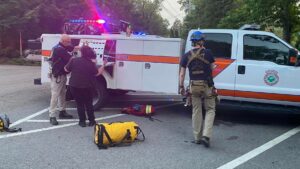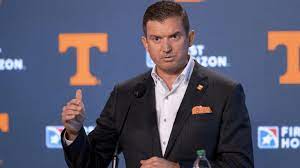Danny White, Bill Majors, and Bob Jones were traveling together from rural West Knox County to the school when their VW Beetle was struck by the “Tennessean” headed toward Knoxville.
Hastily zipping across the West Knoxville train line are drivers eager to go to work. Some barely look around when they go over.

Most people are undoubtedly unaware of one of the worst days in University of Tennessee history, which occurred 58 years ago at this location on Cessna Road and Westland Drive.
At that point, three youthful assistant football coaches were being driven to campus in a Volkswagen Beetle when they were t-boned by a passenger train headed for Knoxville.
Against the train they had no chance. The Southern Railway “Tennessean” crushed the car like a beer can. It tossed it 96 feet down the tracks.
All that existed back then to warn victims Bob Jones, Bill Majors and Charlie Rash was a wooden railroad crossing sign. Today, in a neighborhood packed with homes, there are flashing lights but no gate to alert when a train is approaching.
Some neighbors tell WBIR they worry about the crossing. This summer one contacted 10News and a Knox County commissioner seeking change.
As a result, the city of Knoxville has decided to make improvements.
It has no plans to put in a crossing gate. But it will add signage, pavement markings and stop lines by the end of the month, said Karen McKeehan, the city’s transportation engineering chief.
Because of what happened Oct. 18, 1965, three wives became widows and seven boys lost their daddies.

“If you look at this stretch of road, you have two or three other crossings that have gates, literally right down the road here, and this one doesn’t,” said Knox County Commissioner Larsen Jay, standing at the scene.
“And, of course, this is the scene of a really tragic accident long, long ago. But it’s an area that everybody continues to have more concerns about because the traffic continues to grow, the population continues to grow, and the railroad’s not going anywhere.”
Maybe Jones, Majors and Rash will be the last lives lost at Cessna and Westland.
The week was supposed to be a happy one. Everyone was happy, until the train crash.
UT’s football team had just tied Alabama 7-7 two days before in Birmingham, a moral victory for a Vols squad on its way to better days after several mediocre to just plain bad years.
As he had many mornings before, Rash set out early that Monday to pick up first Jones from his Deane Hill apartments home on Gleason Drive and then Majors, who lived not far away on Cessna.
Rash, 28, a Missouri native, coached the offensive line; Majors, 26, a Tennessee native son, UT alum and brother of UT legend John Majors, handled defensive backs; and Jones, 30, a Texas native who coached offensive ends.
Majors said goodbye to his family in the Cessna Road rancher and climbed into the Beetle.
Rash put the compact in gear and headed down the hill the short distance to Westland. Campus sat about 8 miles away.
Was Charlie in a hurry? We don’t know. Did something distract him? We don’t know.
He’d been bothered by kidney stones a few days before, longtime Vols historian Tom Mattingly told WBIR. Was that a factor in the crash? We don’t know.
Rash, 28, a Missouri native, coached the offensive line; Majors, 26, a Tennessee native son, UT alum and brother of UT legend John Majors, handled defensive backs; and Jones, 30, a Texas native who coached offensive ends.
Majors said goodbye to his family in the Cessna Road rancher and climbed into the Beetle.
Rash put the compact in gear and headed down the hill the short distance to Westland. Campus sat about 8 miles away.
Was Charlie in a hurry? We don’t know. Did something distract him? We don’t know.
He’d been bothered by kidney stones a few days before, longtime Vols historian Tom Mattingly told WBIR. Was that a factor in the crash? We don’t know.
The week was supposed to be a happy one. Everyone was happy, until the train crash.
UT’s football team had just tied Alabama 7-7 two days before in Birmingham, a moral victory for a Vols squad on its way to better days after several mediocre to just plain bad years.
As he had many mornings before, Rash set out early that Monday to pick up first Jones from his Deane Hill apartments home on Gleason Drive and then Majors, who lived not far away on Cessna.
The violence of the collision makes clear Rash had no time to react to the oncoming locomotive.
The Southern engineer, who was running late, would later say he spotted the car on the tracks in the pre-dawn from about 500 feet away and threw on his brakes. Considering his speed, it made little difference.
The train slammed into the right side of the Volkswagen, separating the rear engine from the rest of the German car. Jones and Majors died at impact; Rash suffered severe head injuries that required hours of surgery.
“You look at the picture of what the train did to the car,” Mattingly said. “It hits me right here.”
The car landed in a crumpled heap in a gulley on the south side of the tracks. The train came to a stop nearly a mile down the line.
Authorities later would find Jones’ wristwatch in the wreckage. He’d gotten it while helping Baylor University beat UT in the 1957 Sugar Bowl.
The watch revealed to investigators the time of the crash: It had stopped at 6:53.
Back in 1965, the area still was rural. what they used to call the country. West Town Mall hadn’t been built yet. THP hadn’t yet built a regional headquarters on Kingston Pike and Buckingham Road.




